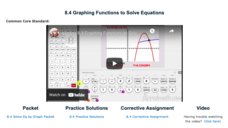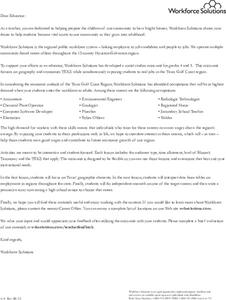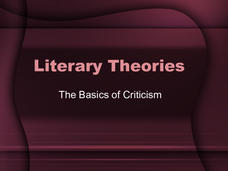Children’s Hospital of Philadelphia
Discovery and Development of Vaccines
Stop the spread. Pupils work through two activities to gain an understanding of vaccines and immunity. Learners research different types of vaccines and how they are made and explore the advantages and disadvantages of them. Using a...
Bonneville
Introduction to Energy
Transform the classroom with energy. Pupils learn about different types of energy and practice identifying the types in the first lesson of six in a solar versus wind energy unit. The class sees examples of how one type of energy can be...
Bonneville
Variables Affecting Wind Turbine Power
Design the best from the best. Groups work together to come up with the best configuration of different variables that affect a wind turbine. The teams choose from several variables such as the number of blades, the angle of the blades,...
University of Colorado
Using a Fancy Spectrograph
Put the spectrograph to good use. Using a spectrograph individuals built themselves, young scientists examine and record the emission spectra of different light sources. They use the spectra to compare and contrast the compositions of...
Flipped Math
Calculus AB/BC - Determining Limits Using the Squeeze Theorem
Sandwich the video in between lessons. Scholars learn about the Squeeze Theorem, or Sandwich Theorem, in the eighth of 18 videos in Unit 1 - Limits and Continuity. After seeing a few examples, they look at different situations to...
Museum of the American Revolution
Leadership and Alexander Hamilton
Alexander Hamilton serves as a model in a lesson that asks young political scientists to consider the strengths and weaknesses of six different leadership styles. They read a brief overview of Hamilton's activities before, during, and...
PBS
Investigating Daily and Seasonal Weather
Talking about weather isn't just for making conversation. Young scientists gather evidence from an interactive activity to make connections between daily and seasonal weather. They analyze data from different areas and compare the...
PBS
Investigating Seasonal Temperature and Precipitation Variations
Weather seems unpredictable, but is it really? Learners collect weather data from online interactives and build data displays. They use their displays to identify temperature and precipitation patterns in different areas.
EngageNY
Presentation of Events: Comparing Two Authors
Give a little clue! Readers learn how context clues can help them determine the meaning of words by viewing a Context Clues Resource sheet then completing a Context Clues
practice sheet. They then compare events presented by two...
C-SPAN
1968: The Poor People's Campaign
The Poor People's Campaign of 1968 marked a shift in the civil rights movement to economic issues. Speakers in four C-SPAN video clips discuss different aspects of the campaign including Resurrection City, the Economic Bill of Rights,...
Digital Public Library of America
Fannie Lou Hamer and the Civil Rights Movement in Rural Mississippi
Good primary resources, offering different perspectives on important issues and events, are hard to find. A packet of 12 primary source images, videos, audio recordings, records, and newspaper articles related to the 1960s civil rights...
American Chemical Society
Great Electron Ripoff
Create a charge in the classroom. Using pieces of cellophane tape, a plastic grocery bag, and a balloon, learners investigate the effects of static electricity. Pupils create different charges in the materials and observe whether they...
American Chemical Society
Density and Sinking and Floating
Keep your class afloat with a hands-on density lesson. The challenging lesson has learners experiment with different materials to compare their densities. They learn that increasing or decreasing the amount of the material doesn't change...
American Chemical Society
Mixing Liquids to Identify an Unknown Liquid
Yellow and blue make green in a colorful lesson on liquid solutions. The seventh installment of a 16-part Inquiry to Action series asks pupils to mix different-colored solutions and record their observations. They then use their...
American Chemical Society
Identifying an Unknown Liquid
Liquids are what's the matter with the lesson! Learners investigate properties of different liquids as they interact with various types of paper. They then use their observations to identify a mystery liquid to finish the sixth lesson in...
American Chemical Society
Dissolving M-and-Ms
Learning ... how sweet it is! A hands-on lesson uses colored candies to demonstrate how positive and negative charges interact. Pupils use different types of liquids and watch as the color from the candies spreads—or doesn't.
Flipped Math
Graphing Functions to Solve Equations
Intersections become solutions. Scholars watch a video on using a graphing calculator to find the solution to an equation in one variable. While watching the presentation, pupils practice working some of the examples and compare their...
PBS
No Slip Grip
The force will be with you during an inquiry-based lesson focused on friction. Young scientists explore the effect of different surfaces on friction. They use rubber bands to measure the amount of force needed to move an object on the...
American Chemical Society
Designing an Absorbency Test
Time to soak up some learning! A hands-on lesson teaches learners about the absorbency properties of substances. They conduct tests by dipping different materials in water to determine which hold water and then complete a handout to...
PBS
Terrific Trees
Engage in a shady activity to practice measurement techniques. Classes venture outside to collect measurements of various trees, using different strategies to measure the height, trunk circumference, width, and crown size. Then they...
NASA
Make a Planetary Exploration Balloon
Balloons aren't just for parties! An inquiry-based lesson explores the idea of using balloons for space exploration. Learners become engineers as they attempt to control the ascent and descent of a helium balloon using different masses.
Workforce Solutions
Workforce Solutions 4-5 Lessons
Four lessons focus on job opportunities in Texas. In the first lesson, scholars examine the geography of Texas in preparation for analyzing data that showcases the economy of different regions. Lesson three challenges pupils to research...
Livaudais-Baker English Classroom
Literary Theories
Introduce ELA scholars to the basics of literary criticism with a 41-slide presentation that identifies eight different approaches to critical analysis. Each approach is defined, and advantages and disadvantages are listed. Also included...
GLOBE Program
Calculating Relative Air Mass
Combine math and science with fun in the sun! Scientists build a solar gnomon using reusable materials to calculate relative air mass. Mathematicians measure the pole's shadow and use the data to solve for relative air mass....
Other popular searches
- Similarities and Differences
- Culture Differences
- Respecting Differences
- Gender Differences
- Estimating Differences
- Regional Differences
- Individual Differences
- Accepting Differences
- Estimating Sums Differences
- Ethnic Differences
- Differences in People
- Alcohol Differences

























